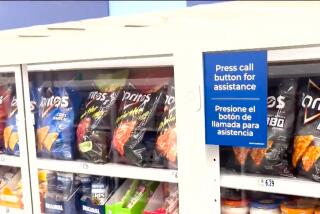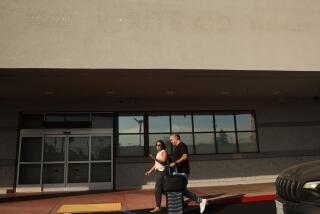A Bitter Pill for Pharmacist, His Customers
In an era when mega-banks are gobbling up their competitors and family-run stores are struggling to survive, Bob Livon’s decision to shut down his Northridge Hills Pharmacy should have come as no surprise.
But it wasn’t the 60-hour workweeks or the face-offs with armed robbers that pushed him over the edge. And it wasn’t competition from the big chain drugstores that did him in. Livon, it seems, was a casualty of a revolution in health-care financing that has paid off for some and shortchanged others.
So last year along with Christmas cards his 1,200 customers received announcements that his Porter Ranch pharmacy would soon close, to merge with a Thrifty drugstore nearby.
Little would change for us, he promised. He would work behind the Thrifty counter from 8 to 6 and dispense our prescriptions with the same personal care we’d come to expect.
But something did change, from the moment he locked his doors for the final time.
*
We used to marvel at how lucky we were to have the pharmacist we called Dr. Bob, with his tidy little shop tucked between a beauty parlor and dress store in a Tampa Avenue mini-mall.
For 19 years, with unfailing patience and good humor, he tended our families through births and deaths, chicken pox and heart attacks, broken arms and broken hearts.
When the Northridge earthquake closed the big drugstores for days on end, Dr. Bob spent hours on his knees on the floor of his shop, combing through broken glass and spilled pills to salvage enough medicine to get us through.
He was not just our neighbor--he lives with his family just a mile from the old store--but our counselor and confidant. I came to understand why on national surveys Americans rate pharmacists as the most trustworthy of professionals. There was no question I was too embarrassed to ask him, no advice of his I did not trust.
He would track down busy doctors or wrestle with balky insurance companies. And ultimately, it was that frustrating dance with insurance companies that did him in.
“It wasn’t the job or the hours that drove me out,” he says now, from the tiny cubicle that serves as his new digs.
He came here from Minnesota in 1978 with one dream--running his own pharmacy. And all along, “I loved what I was doing. . . . But I wasn’t making enough to keep my doors open.”
*
The forces that did in Northridge Hills are killing pharmacies across the state. In fact, pharmacy licenses in California are being surrendered at the rate of one per working day.
“My phone rings on a regular basis . . . with pharmacists saying they’re losing their shirts,” says Carlo Michelotti, head of the California Pharmacists Assn. “These people are between a rock and a hard place.”
That rock is the growing use of managed-care medical programs, run by insurance companies that pay pharmacists only a fraction of the per-prescription fees they used to get. And the hard place is their struggle to hold on to customers courted by cheaper mail-order prescription firms.
Surveys show it costs about $6 today to fill the average prescription--factoring in everything from pill bottles to employee salaries to the pharmacy’s computer service. But most private insurance groups pay pharmacies less than $3 per prescription, Michelotti says, and even Medicare pays only $4.
“Now I ask you how in the world can you make money on a process like that?” Michelotti asks.
In the old days, Michelotti says, most consumers paid for their own medicines and prices were dictated by what wholesalers charged the stores.
Now, pharmacies are shut out of the bulk of the prescription trade unless they sign on with insurance companies at prices the companies dictate, which hardly cover the medicines’ wholesale costs.
Large chain drugstores can absorb some of the loss because their pharmacies bring in customers who buy other, high-profit items, such as cards or candy. And pharmacy purchases account for only a small fraction of their sales anyway.
“There’s no way the community pharmacies can compete,” says Ed Hasson, considered the dean of Valley druggists during the 21 years he ran Royal Hills Pharmacy in West Hills.
Hasson can remember when he had $100,000 worth of inventory--all paid for--and his pharmacy was worth $350,000. But he walked away last month with nothing.
“At first, you pay yourself a little less and less and you try to hang in there and survive,” he said. “But it got to the point where I owed my suppliers $95,000 I couldn’t pay.” To cover that debt, he sold Royal Hills to a corporation with deeper pockets.
*
Now, like the rest of Dr. Bob’s loyal customers, I shuffle impatiently in line at Thrifty, trying to catch his eye as he bustles about, filling prescriptions for people he does not know.
Behind me is a neighbor I recognize only because our paths crossed at his store. “Don’t you just hate this?” she fumes. “How could he do this to us?”
Like me, she is not sure whom to be mad at; what was to Bob a way to survive feels to us like a personal affront.
Ahead of us in line, a woman is complaining to a befuddled young pharmacist that she was shorted on her pills. “It was supposed to be 60 and I take two a day. It’s been 28 days and it’s empty,” she shouts, flinging the bottle across the counter. “You do the math!”
I am here on my second trip of the day, because the first time I came I was given the wrong antibiotic for my daughter’s ear infection. She is supposed to get the chewables, I explain to the young woman working the pharmacy cash register. She doesn’t know how to swallow pills.
The woman shrugs. We didn’t know, she says, maybe the prescription didn’t say.
Maybe it didn’t. But Dr. Bob would have known. She’s only 6 years old. Dr. Bob would have remembered that.
Columnist Scott Harris is on vacation. Times staff writer Sandy Banks will write occasional columns in his absence.
More to Read
Inside the business of entertainment
The Wide Shot brings you news, analysis and insights on everything from streaming wars to production — and what it all means for the future.
You may occasionally receive promotional content from the Los Angeles Times.









